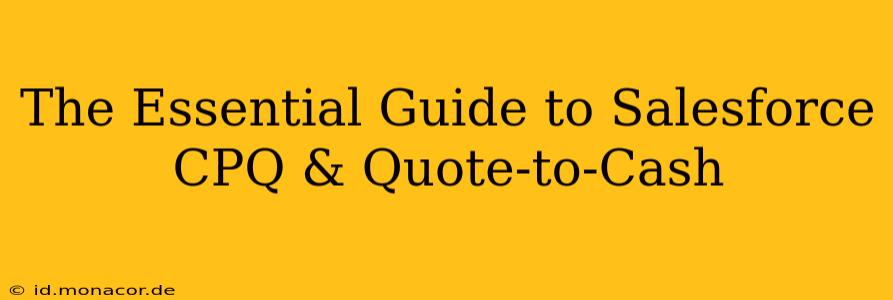Salesforce CPQ (Configure, Price, Quote) and Quote-to-Cash are powerful tools transforming how businesses manage their sales processes. This comprehensive guide will delve into the intricacies of both, exploring their benefits, functionalities, and how they seamlessly integrate to optimize your revenue cycle. Whether you're a seasoned Salesforce user or just starting to explore these solutions, this guide will equip you with the knowledge to make informed decisions and unlock the full potential of your sales operations.
What is Salesforce CPQ?
Salesforce CPQ is a leading Configure, Price, Quote application designed to streamline and automate the quoting process. It allows sales teams to quickly and accurately generate complex quotes, ensuring consistent pricing and reducing errors. By configuring products and services, CPQ automatically calculates pricing, discounts, and taxes, eliminating manual calculations and improving accuracy. This translates to faster quote turnaround times, happier customers, and ultimately, increased revenue.
Key benefits of Salesforce CPQ include:
- Automated Pricing: Eliminate manual pricing calculations and ensure accuracy across all quotes.
- Improved Sales Efficiency: Speed up the quoting process, allowing sales reps to focus on closing deals.
- Reduced Errors: Minimize errors caused by manual data entry and calculations.
- Enhanced Customer Experience: Provide accurate and timely quotes, leading to improved customer satisfaction.
- Increased Revenue: Close deals faster and more efficiently, leading to higher revenue generation.
What is Quote-to-Cash?
Quote-to-Cash (QTC) encompasses the entire process from generating a quote to receiving payment. It involves several key stages, including:
- Quote Generation: Creating and sending accurate quotes to prospective customers.
- Order Management: Processing and managing customer orders efficiently.
- Revenue Recognition: Accurately recognizing revenue according to accounting standards.
- Billing & Collections: Generating invoices and collecting payments from customers.
Effective Quote-to-Cash processes are crucial for improving operational efficiency, reducing costs, and accelerating revenue recognition. Salesforce CPQ plays a vital role in optimizing this process by automating many of the initial steps.
How Salesforce CPQ Integrates with Quote-to-Cash
Salesforce CPQ seamlessly integrates with other Salesforce clouds, such as Sales Cloud and Service Cloud, to form a complete Quote-to-Cash solution. This integration automates many steps in the QTC process, creating a streamlined workflow that improves efficiency and accuracy.
For example, CPQ can automatically:
- Update opportunity records in Sales Cloud upon quote generation.
- Generate orders in Salesforce once a quote is accepted.
- Trigger revenue recognition processes based on order fulfillment.
- Integrate with billing systems for automated invoice generation.
This end-to-end automation eliminates manual data entry, reduces errors, and significantly speeds up the entire QTC cycle.
What are the Benefits of Using Salesforce CPQ and Quote-to-Cash Together?
The combined power of Salesforce CPQ and a well-defined Quote-to-Cash process leads to several significant benefits:
- Faster Deal Closure: Streamlined processes and automated workflows allow for faster quote generation and order processing, resulting in shorter sales cycles.
- Improved Accuracy: Automated calculations and data entry minimize errors, ensuring accurate pricing and revenue recognition.
- Increased Revenue: Faster deal closure and improved accuracy lead directly to increased revenue generation.
- Better Customer Satisfaction: Customers receive accurate and timely quotes, improving their overall experience.
- Enhanced Visibility and Control: Real-time visibility into the entire Quote-to-Cash process allows for better management and control.
- Reduced Operational Costs: Automation reduces manual effort, minimizing costs associated with administrative tasks.
How Can I Implement Salesforce CPQ and Quote-to-Cash?
Implementing Salesforce CPQ and optimizing your Quote-to-Cash process requires careful planning and execution. Key steps include:
- Defining your requirements: Clearly define your business needs and objectives.
- Choosing the right implementation partner: Select a reputable partner with experience in Salesforce CPQ implementations.
- Data migration: Migrate existing data into the Salesforce CPQ environment.
- Training and user adoption: Provide comprehensive training to your sales and administrative teams.
- Ongoing optimization: Continuously monitor and optimize your processes to maximize efficiency.
What are the common challenges in implementing Salesforce CPQ and Quote-to-Cash?
While immensely beneficial, implementing Salesforce CPQ and a robust QTC process presents some challenges:
- Complexity: The system can be complex, requiring skilled resources for implementation and maintenance.
- Customization: Extensive customization might be needed to fully meet specific business requirements.
- Integration: Integrating CPQ with existing systems can be challenging.
- User Adoption: Ensuring proper user adoption and training is critical for success.
How much does Salesforce CPQ cost?
The cost of Salesforce CPQ varies depending on factors like the number of users, required features, and implementation complexity. It's best to contact Salesforce directly or a certified partner for a customized quote.
Conclusion
Salesforce CPQ and a well-structured Quote-to-Cash process are essential for businesses seeking to optimize their sales operations and drive revenue growth. By implementing these solutions, businesses can streamline their sales cycle, increase accuracy, improve customer satisfaction, and gain valuable insights into their revenue performance. Careful planning, a strong implementation partner, and ongoing optimization are crucial for realizing the full potential of these powerful tools.

